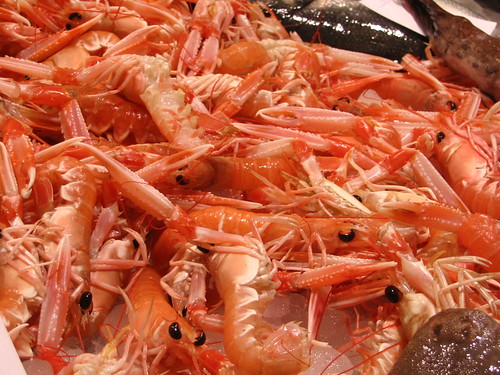Was this prehistoric ‘killer shrimp’ as fierce as it looked?
Shrimp #Shrimp

The invertebrate was thought to be one of Earth’s first super predators. With compound eyes sitting on stalks, a strange circular mouth, and grasping appendages at the front of its head, Anomalocaris canadensis seemed like the terror of small creatures that swarmed the Cambrian seas. But a new analysis has found that the “strange shrimp” was not such a rapacious predator, instead plucking soft-bodied prey out of the water columns of primordial seas.
The critical evidence comes from the spiky, segmented appendages at the front of the animal’s body. Working from well-preserved specimens of Anomalocaris from 508-million-year-old rocks in British Columbia known as the Burgess Shale, paleontologists created three-dimensional models to assess the mobility and strength of the invertebrate’s spiky-looking grabbers.
Up until now, Anomalocaris looked like just the sort of creature that would feed on the hard-shelled, pill bug-like trilobites that thrived during the Cambrian. Rare finds of trilobites with apparent bites taken out of them and fossil feces full of trilobite parts indicated that something was able to chomp through the thick exoskeletons of the bottom-crawlers, and Anomalocaris looked like just the sort of animal capable of such damage.
But according to a new analysis, Anomalocaris would have had a great deal of trouble crunching through the mineralized trilobite shells. In the study, published in Proceedings of the Royal Society B., American Museum of Natural History paleontologist Russell Bicknell and colleagues find that the appendages of Anomalocaris could move quickly, evolved for speed over grappling with struggling prey.
Combined with other details of the animal’s anatomy, such as the compound eyes, the researchers envision Anomalocaris swimming through sunny seas and plucking out comb jellies, tadpole-like animals called vetulicolians, and other soft morsels. The arthropod, an invertebrate with an exoskeleton and segmented body, may have also preyed on other arthropods with softer shells, distant relatives of today’s crustaceans and insects.
A prehistoric killer shrimp?
Scientists’ efforts to understand the ancient animal go back more than a century. Anomalocaris means “strange shrimp,” a name coined in 1892 from isolated body parts that looked like crustaceans. Over time, however, those supposed “shrimp” began to look more like the appendages of something bigger. It wasn’t until 1985 that the entire creature came into view, a species that lived in the seas of ancient Earth and looked unlike anything experts could have dreamed.
Restored to its full shape, Anomalocaris looked like a fearsome predator. “This image was baked in right away,” says Harvard University paleontologist Joanna Wolfe, who was not involved in the new study.
Reaching almost two feet in length, Anomalocaris was one of the largest animals found in the famed Burgess Shale, which preserve a wealth of Cambrian fossils. Flaps lined the animal’s body, helping to propel it through the water, and the grasping appendages seemed perfectly suited to stuffing prey into the animal’s circular mouth below its head.
Most impressive of all, however, were the eyes. Anomalocaris had compound eyes made up of 16,000 lenses, allowing the animal to see in finer detail than the trilobites it supposedly fed upon. The creature’s eyesight and appetite were even thought to fuel an evolutionary “arms race” between predators and prey that increased biodiversity in the seas during the Cambrian.
“There is a lot of evidence to say this animal was very capable of seeing things really well,” says Bicknell. The discovery of fossilized feces full of trilobite parts seemed to bolster the case that Anomalocaris had evolved to grab and bite into other animals with hard exoskeletons. Paleontologists expected that the animal’s method of feeding was to “grab and stab repeatedly, while shoving the trilobite towards the mouth until enough cracks were formed for it to rupture,” Wolfe says.
But Bicknell and other paleontologists have been skeptical of the invertebrate’s ravenous reputation, prompting new research.
Plucking easy prey
After creating three-dimensional models of Anomalocaris’ great appendages from delicate fossils, as well as some modern species for comparison, Bicknell and colleagues ran them through various analyses to examine their flexibility, speed, and strength. The experts did not find the arms of a predator that regularly dined on trilobites and other hard-shelled food.
Despite the arms being capable of picking up prey and bringing it to the animal’s mouth, they were not very good at grasping. When flexed, they could not entirely wrap back on themselves as might be expected. Part of the reason has to do with spiny projections on the bottom of the appendages called endites. These small spikes were relatively fragile and prevented the arms from curling up tight like the fiddlehead of a young fern.
Stress tests indicated that the endites might have been damaged if Anomalocaris attempted to tightly grasp hard-shelled prey. If it attempted to catch a trilobite, Bicknell says, “I think it would likely have damaged the spines, likely breaking them and causing Anomalocaris a deal of pain.” With this new evidence, Bicknell and his team had to rethink how this animal was living.
“I think they did a very impressive job here,” Wolfe says, noting that models like this can always be revised based on new evidence. The study even alters how experts might envision Anomalocaris while swimming, holding its appendages outstretched in front rather than curled up beneath its head as in many artistic renditions.
Rather than prowling the seafloor in search of crunchy trilobites, Anomalocaris was what experts call a nektonic predator, swimming through the open water in search of whatever small snacks its complex eyes could spot. The image is just the latest adjustment in paleontologists’ attempts to understand an animal with no living counterpart, a fossil known for the puzzles its strange anatomy presents.